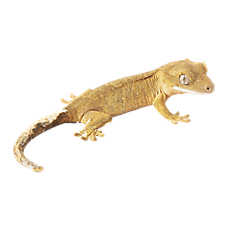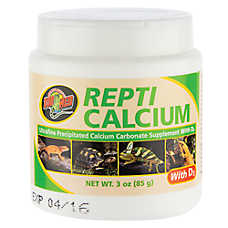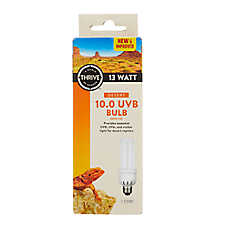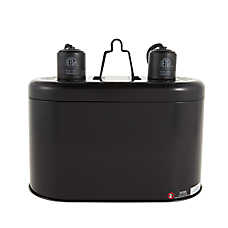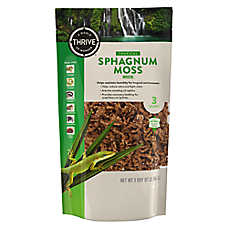Crested Gecko Care Guide
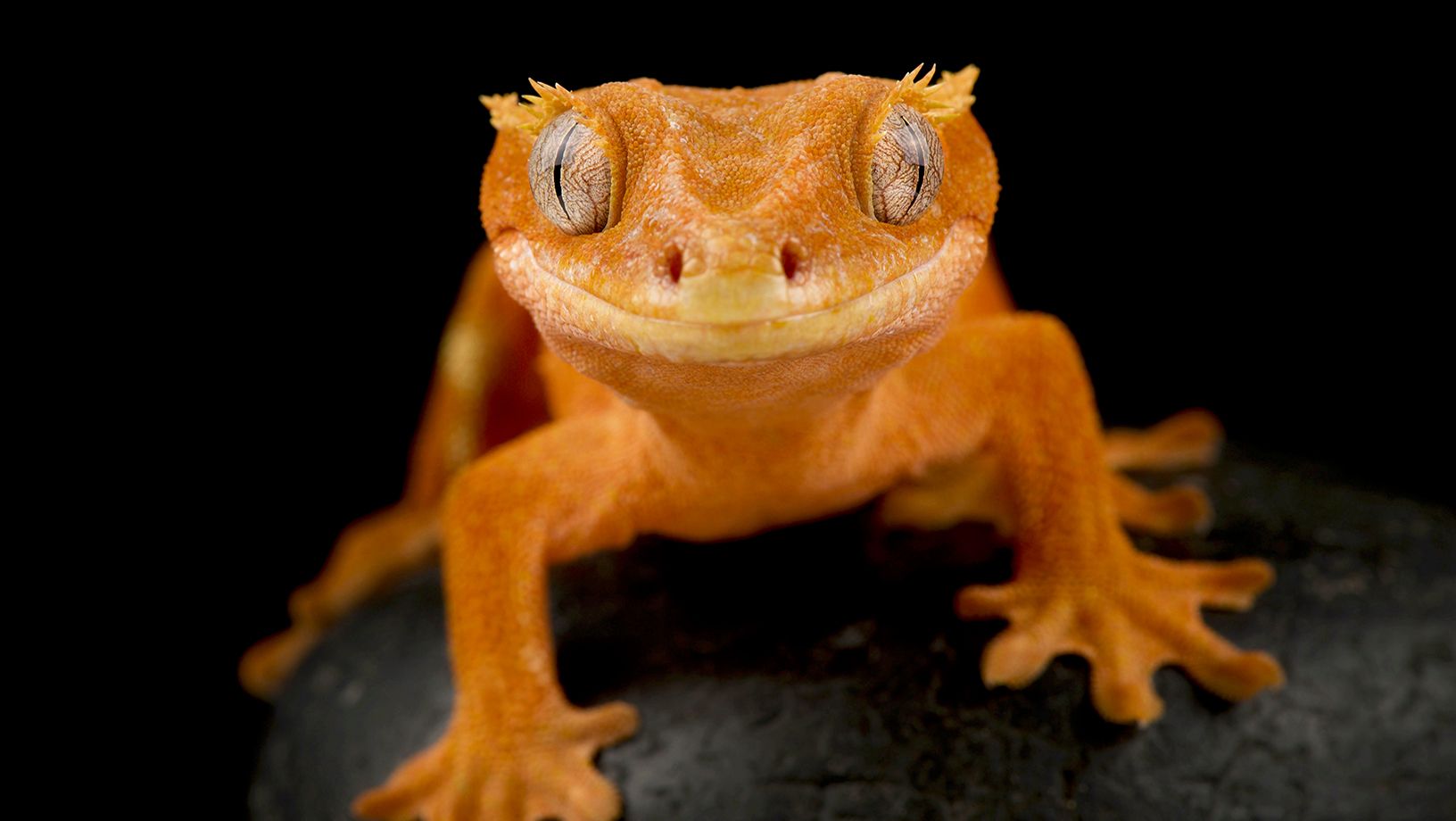
In this Article
Expressive and Adventurous Crested Geckos!
Crested geckos (Correlophus ciliatus) are eye-catching, arboreal lizard’s native to the islands of New Caledonia off the coast of Australia. Sometimes called "eyelash geckos," they are known for the distinctive fringed ridge above each eye. A unique feature about these geckos is that they do not have eyelids! Instead, they use their tongues to clean their eyes, which are protected by a clear, scale-like covering called a spectacle.
Their coloration varies widely depending on genetics, environment, and mood. Colors may include tan, orange, olive, or rust, and their pattern often intensifies when the gecko becomes excited or alert, a behavior known as “firing up.”
Crested Gecko species profile:
Size: Crested geckos grow up to 10 inches (25 cm) from nose to tip of their tail.
Lifespan: They on average live 15-20 years in captivity
Behavior: Eyelash crested geckos love to climb and leap around their habitat as they move. They like to jump, even doing leaps of faith off your hands! Crested geckos also exhibit a behavior called “firing up” when excited. When a crested gecko gets fired up, their normal color changes- the dark parts of them get even darker and the light parts get lighter, making them high contrast and visually very distinct!
Temperament: They are generally docile with people, but often show signs of aggression amongst each other so it is recommended to house them by themselves. Crested geckos can become used to handling through regular 5-min interactions a couple times a week, but generally we do not recommend holding them for longer than 15min at a time to minimize having them out of their warm, humid habitat too long. Because they like to jump, always have a soft-landing zone under you when holding your gecko in case it jumps off your hands.
Important fact: unlike other species of gecko, crested geckos do NOT regrow their tails if they lose them. Take extra care, and never grasp your gecko by the tail
Setting up your Crested Gecko habitat
Crested geckos thrive in tall, humid enclosures with plenty of climbing surfaces and plant cover. As arboreal lizards, they spend most of their time off the ground, so vertical space and secure branches are essential.
Enclosure size and structure
- Use a well-ventilated terrarium with a screened lid to promote airflow
- The minimum size for an adult crested gecko is 18 x 18 x 36 inches
- Choose a taller enclosure over a wider one to support natural climbing behavior
- Line the floor with reptile carpet or a 2 to 3 inch layer of coconut fiber, sphagnum moss, and bark mix
- Avoid loose particle substrates like sand or gravel that could cause impaction if ingested
- Spot clean daily and perform a full bedding replacement and deep clean monthly
Heat and lighting
- Provide gentle heat: Use a low-wattage heat bulb, deep heat projector, or ceramic heat emitter to maintain a comfortable temperature.
- Nighttime temperature: If you use a heating element like a ceramic emitter, turn it off for 12 hours at night, as long as the ambient room temperature stays above 65°F (18°C).
- Lighting schedule: Always turn off lights at night to mimic natural day-night cycles.
- UVB lighting benefits: Recent studies suggest that UVB light can be beneficial for crested geckos. UVB exposure helps them synthesize vitamin D3 naturally (reducing the need for supplements) and provides a light wavelength they can see—even though we cannot.
- Recommendation: While UVB lighting isn’t strictly required for survival, we recommend adding a low-output UVB bulb at the top of the enclosure (outside the mesh) to support overall health and well-being.
Climbing surfaces and terrarium decorations
Furnish the enclosure with a mix of horizontal and vertical climbing structures:
- Use real or artificial branches, vines, driftwood, cork bark, and broad-leafed plants
- Provide multiple hiding spots at different heights and on both the warm and cool sides of the habitat to allow thermoregulation and reduce stress
- All décor should be stable, secure, and easy to clean
Crested geckos prefer visually dense enclosures. Cluttered habitats with lots of vertical cover help reduce handling stress and support natural activity patterns.
Temperature and humidity requirements
Crested geckos require a gentle temperature gradient and moderate ambient humidity. Use two thermometers to monitor conditions in both the cool zone (lower) and warm zone (upper), and a digital hygrometer to measure humidity.
Zone | Temperature |
Cool side (bottom) | 75 to 80°F (24 to 27°C) |
Warm side (top) | 80 to 85°F (27 to 29°C) |
Basking area | 85 to 87°F (29 to 30°C) |
Night | 65 to 75°F (18 to 24°C) |
Humidity | 40 to 50 percent, with brief increases up to 80 percent during misting |
Crested Gecko care and feeding
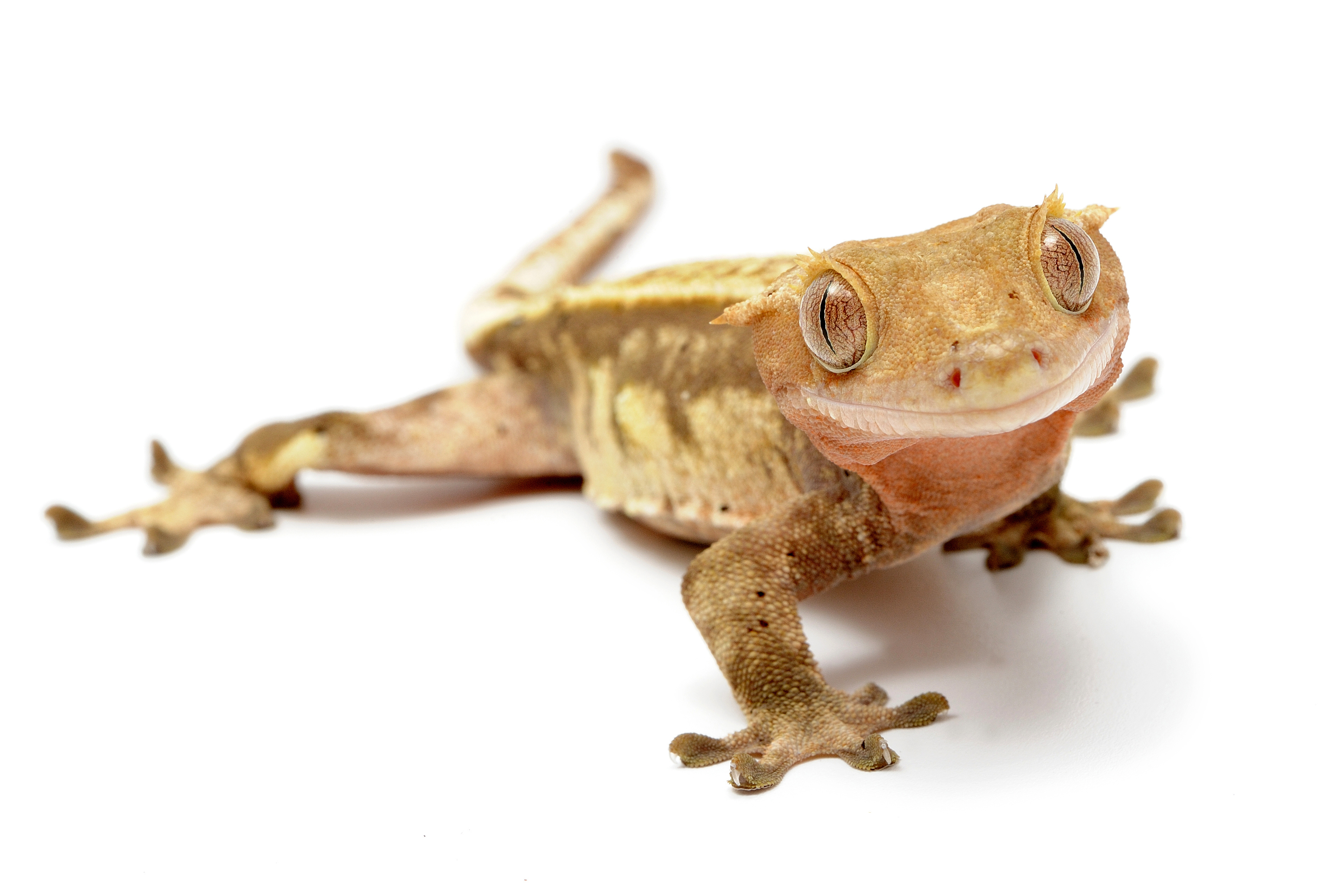
Feeding
Crested geckos require a combination of nutritionally balanced powdered diets and live, gut-loaded insects to meet their dietary needs. Their feeding routine varies by age and activity level. Gut-loaded insects are feeder insects that have been fed a nutritious diet (such as fruits, vegetables, and calcium-rich foods) 24–48 hours before being offered to your gecko. This process boosts the insects’ nutrient content, making them a healthier food source and supporting your gecko’s long-term health.
Live insect diet
Offer a mix of gut-loaded feeder insects that are no larger than the width of your gecko’s head:
- Crickets
- Dubia roaches
- Small hornworms
- Black soldier fly larvae
Remove uneaten insects after 15 to 30 minutes to prevent stress or injury.
Juveniles (under 12 months)
- Feed daily or every other day
- Dust insects with calcium powder 2 to 3 times per week
- Dust with a reptile multivitamin once per week, or as directed by your veterinarian
Adults
- Feed 1 to 2 times per week
- Dust insects with calcium powder 2 to 3 times per week
- Dust with a reptile multivitamin twice per month, or as directed by your veterinarian
Powdered gecko diet
Crested geckos should always have access to a commercial powdered diet formulated for their species. This powdered mix is typically rehydrated into a paste or slurry according to the manufacturer’s instructions.
- Offer the powdered diet three to four times per week, even when feeding live insects
- Remove uneaten portions daily to prevent spoilage or mold
- Powdered diets may be dusted onto insects as an additional nutrient boost
Look for high-quality commercial diets made specifically for crested geckos. These are designed to meet their needs for protein, fruit sugars, and essential vitamins.
Hydration
Provide a shallow dish of clean, fresh water at all times. Change the water daily and clean the dish regularly. In addition to drinking from dishes, crested geckos often lick water droplets from leaves and enclosure walls after misting.
Feeding safety
- Do not offer wild insects. These may carry parasites or pesticide residue
- Monitor your gecko’s weight and appetite regularly
- If your gecko refuses food or powder diet for more than one week, check habitat conditions and consult a reptile veterinarian
When to see a vet
In addition to regularly scheduled appointments, contact your reptile veterinarian if you notice the following signs:
- Hiding more than usual
- Eating or drinking less; weight loss
- Swollen joints or reluctance to move
- Discharge from the eyes, nose or mouth
Shedding problems; discolored skin • Runny droppings for more than two days • Decreased frequency in droppings • Increased basking time • Tail bent over or damaged – sign of floppy tail syndrome Go to “find a vet” on arav.org for help finding a reptile veterinarian in your area.
NOTE: Most, if not all, reptiles carry Salmonella bacteria in their intestinal tract and intermittently or continuously shed these bacteria in their feces, so they are unsuitable pets for very young children and those with compromised immune systems. Good hygiene must always be practiced around all reptiles, and hands should be washed before and after interacting with reptiles.
SHOPPING CHECKLIST
- Well-ventilated terrarium that’s taller than it is wide.
- Juvenile: minimum size 10” L x 12” W x 20” H
- Adult: Minimum size 18” L x 18” W x 36”H
- screened lid, if applicable
- habitat thermometer(s) and hygrometer
- daytime heat lamp and bulb
- spray bottle for misting
- Combination of coconut fiber, reptile bark and sphagnum moss bedding
- artificial/natural rock or wood hiding spot
- branches for climbing and hiding
- hide (preferably arboreal)
- food bowl
- water bowl
- live prey insects (gut-loaded crickets, dubia roaches, small hornworms, black soldier fly larva.)
- complete nutritional crested gecko diet food
- Calcium supplement and vitamin supplement
Ready to learn more?
This guide is a great starting place, but we encourage you to do more research on the individual species that you are keeping so that you can be as successful as possible! Related guides:
- Reptile & Amphibian Heating & Lighting
- Setting Up a Reptile or Amphibian Habitat
- Understanding Zoonotic Disease
- Feeder Insect Care & Setup
FAQs
How often should I feed my crested gecko?
Juveniles should be fed daily or every other day. Adults typically eat two to three times per week. Insects and powdered diets can be offered on alternating days or as part of the same routine, depending on preference and nutritional balance.
Juveniles should be fed daily or every other day. Adults typically eat two to three times per week. Insects and powdered diets can be offered on alternating days or as part of the same routine, depending on preference and nutritional balance.
Do crested geckos need live insects?
Yes. While powdered diets provide complete nutrition, crested geckos benefit from the physical activity and enrichment of hunting live prey. A balanced diet includes both insects and a species-specific powdered mix.
Yes. While powdered diets provide complete nutrition, crested geckos benefit from the physical activity and enrichment of hunting live prey. A balanced diet includes both insects and a species-specific powdered mix.
What insects are safe for crested geckos?
Safe options include gut-loaded crickets, dubia roaches, small hornworms, and black soldier fly larvae. Insects should be no wider than your gecko’s head and must be free from pesticides or parasites.
Safe options include gut-loaded crickets, dubia roaches, small hornworms, and black soldier fly larvae. Insects should be no wider than your gecko’s head and must be free from pesticides or parasites.
Can crested geckos regrow their tails?
No. Unlike some other gecko species, crested geckos do not regenerate their tails. If the tail is dropped due to stress or injury, it will not grow back. This does not typically impact the gecko’s long-term health but is permanent.
No. Unlike some other gecko species, crested geckos do not regenerate their tails. If the tail is dropped due to stress or injury, it will not grow back. This does not typically impact the gecko’s long-term health but is permanent.
Do crested geckos need UVB lighting?
UVB is not required for survival, but recent studies show that crested geckos benefit from low-level UVB exposure. It supports vitamin D3 synthesis and may improve long-term health. If used, place the UVB bulb outside the mesh lid and follow a 12-hour light cycle.
UVB is not required for survival, but recent studies show that crested geckos benefit from low-level UVB exposure. It supports vitamin D3 synthesis and may improve long-term health. If used, place the UVB bulb outside the mesh lid and follow a 12-hour light cycle.
How humid should the enclosure be?
Maintain general humidity between 40 and 50 percent. During daily misting, short-term spikes up to 80 percent are beneficial. Always allow the habitat to dry out between misting sessions to prevent bacterial growth.
Maintain general humidity between 40 and 50 percent. During daily misting, short-term spikes up to 80 percent are beneficial. Always allow the habitat to dry out between misting sessions to prevent bacterial growth.
Why is my crested gecko not eating?
Common reasons include low enclosure temperatures, improper humidity, stress, or recent environmental changes. Check habitat conditions first. If appetite does not return within one week, consult a reptile veterinarian.
Common reasons include low enclosure temperatures, improper humidity, stress, or recent environmental changes. Check habitat conditions first. If appetite does not return within one week, consult a reptile veterinarian.
Can I keep more than one crested gecko in the same enclosure?
No. Crested geckos are solitary and may become aggressive when housed together. Each gecko should have its own enclosure to prevent injury or stress.
No. Crested geckos are solitary and may become aggressive when housed together. Each gecko should have its own enclosure to prevent injury or stress.
